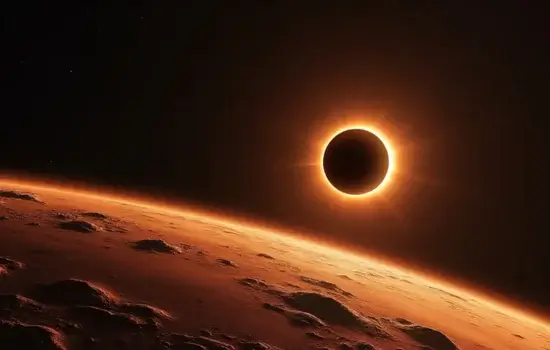The year 2025 is set to feature four significant celestial events: two solar eclipses and two lunar eclipses. However, only one of these will be visible from India, offering a unique opportunity for sky enthusiasts across the country.
Eclipse Schedule for 2025

1. Total Lunar Eclipse – March 14, 2025
The first eclipse of the year is a total lunar eclipse on March 14. Unfortunately, this event will not be observable from India, as it is expected to occur during daylight hours in the region. This eclipse will be visible across parts of America, Western Europe, Western Africa, and over the North and South Atlantic Oceans.
2. Partial Solar Eclipse – March 29, 2025
Following the lunar event, a partial solar eclipse is slated for March 29. India will miss this spectacle as well, with visibility confined to North America, Greenland, Iceland, Europe, and parts of Russia.
3. Total Lunar Eclipse – September 7-8, 2025
The highlight for Indian observers will be the total lunar eclipse occurring on the night of September 7, extending into the early hours of September 8. This event will be fully visible across India, as well as in other parts of Asia, Europe, Antarctica, Australia, and the Indian Ocean region. During a total lunar eclipse, the Earth positions itself between the Sun and the Moon, casting a shadow that envelops the Moon and often imparts a reddish hue, commonly referred to as a “Blood Moon.”
4. Partial Solar Eclipse – September 21-22, 2025
The final eclipse of the year is a partial solar eclipse on September 21-22. This event will not be visible from India, with its path limited to regions such as New Zealand, the South Pacific, and West Antarctica.
Understanding Eclipses
Eclipses are astronomical events that occur when one celestial body moves into the shadow of another. A lunar eclipse transpires when the Earth aligns directly between the Sun and the Moon, causing the Earth’s shadow to fall upon the Moon. This can result in a total, partial, or penumbral lunar eclipse, depending on the alignment. In contrast, a solar eclipse happens when the Moon passes between the Earth and the Sun, temporarily obscuring the Sun’s light. Solar eclipses can be total, partial, or annular, based on the apparent sizes of the Sun and Moon and their alignment.
Significance of the September 7-8 Total Lunar Eclipse
The total lunar eclipse on September 7-8, 2025, holds particular significance for India, being the sole eclipse visible from the country that year. Such events provide valuable opportunities for scientific observation and public engagement with astronomy. Lunar eclipses are safe to view with the naked eye, unlike solar eclipses, which require protective eyewear. This accessibility makes lunar eclipses popular events for educational outreach and amateur astronomy.
Viewing Tips for the Total Lunar Eclipse
For those planning to observe the total lunar eclipse in September, here are some tips to enhance your experience:
- Timing: The eclipse will commence late in the evening of September 7 and continue into the early hours of September 8. Exact timings will vary by location, so it’s advisable to consult local astronomical resources for precise information.
- Location: Choose an observation spot with a clear, unobstructed view of the night sky, away from urban light pollution. Rural areas or elevated locations often provide better visibility.
- Equipment: While the eclipse is visible to the naked eye, using binoculars or a telescope can offer a more detailed view of the Moon’s surface and the progression of the eclipse.
- Photography: For those interested in capturing the event, a camera with manual settings mounted on a tripod is recommended. Experimenting with exposure times can help in obtaining clear images of the eclipsed Moon.
Cultural and Astrological Perspectives
Eclipses have held cultural and astrological significance across civilizations. In various traditions, lunar eclipses are associated with omens, rituals, and myths. Astrologically, they are often linked to endings, revelations, and transformations. While modern science provides clear explanations for these phenomena, the cultural narratives continue to enrich the human experience of celestial events.
Conclusion
The year 2025 presents a quartet of eclipses, with the total lunar eclipse on September 7-8 being the singular event visible from India. This celestial occurrence offers a remarkable opportunity for observation and engagement with the wonders of the night sky. Whether you’re an avid astronomer or a casual observer, mark your calendars for this astronomical spectacle.
Hina Abbasi is Editor and a passionate sports and entertainment content writer at WinnersMaze.com. Hina’s expertise spans across a wide range of sports, and interest in many TV shows allowing her to deliver insightful analysis and compelling stories that resonate with readers.

